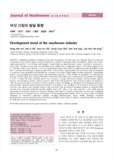

PARTNER
검증된 파트너 제휴사 자료
버섯 산업의 발달 동향
방대한 850만건의 자료 중 주제별로 만들수 있는 최적의 산출물을 해피 캠퍼스에서 체험 하세요 전문가의 지식과 인사이트를 활용하여 쉽고 폭넓게 이해하고 적용할수 있는 기회를 놓치지 마세요
13 페이지
최초등록일 2023.04.05
최종저작일
2016.12

-
 * 본 문서는 배포용으로 복사 및 편집이 불가합니다.
* 본 문서는 배포용으로 복사 및 편집이 불가합니다.
미리보기
서지정보
· 발행기관 : 한국버섯학회
· 수록지 정보 : 한국버섯학회지 / 14권 / 4호
· 저자명 : 유영복, 오민지, 오연이, 신평균, 장갑열, 공원식
영어초록
Worldwide production of mushrooms has been increasing by 10–20% every year. Recently, Pleurotus eryngii and P. nebrodensis have become popular mushroom species for cultivation. In particular, China exceeded 8.7 million tons in 2002, which accounted for 71.5% of total world output. A similar trend was also observed in Korea. Two kinds of mushrooms— Gumji (金芝; Ganoderma) and Seoji—are described in the ancient book 'Samguksagi' (History of the three kingdoms; B.C 57~A.D 668; written by Bu Sik Kim in 1145) during the Korea-dynasty. Many kinds of mushrooms are also described in more than 17 ancient books during the Chosun-dynasty (1392~1910) in Korea. Approximately 200 commercial strains of 38 species of mushrooms were developed and distributed to cultivators. The somatic hybrid variety of oyster mushroom, ‘Wonhyeongneutari,’ was developed by protoplast fusion, and distributed to growers in 1989. Further, the production of mushrooms as food was 199,829 metric tons, valued at 850 billion Korean Won (one trillion won if mushroom factory products are included) in 2015. In Korea, the major cultivated species are P. ostreatus, P. eryngii, Flammulina velutipes, Lentinula edodes, Agaricus bisporus, and Ganoderma lucidum, which account for 90% of the total production. Since mushroom export was initiated in 1960, the export and import of mushrooms have increased in Korea. Technology was developed for liquid spawn production, and automatic cultivation systems led to the reduction of production cost, resulting in the increase in mushroom export. However, some species were imported owing to high production costs for effective cultivation methods. In academia, RDA scientists have conducted mushroom genome projects since 1997. One of the main outcomes is the whole genome sequencing of Flammulina velutipes for molecular breeding. With regard to medicinal mushrooms, we have been conducting genome research on Cordyceps and its related species for developing functional foods. There are various kinds of beneficial substances in mushrooms; mushroom products, including pharmaceuticals, tonics, healthy beverages, functional biotransformants, and processed foods have also became available on the market. In addition, compost and feed can likewise be made from mushroom substrates after harvest.참고자료
· 없음태그
-
자료후기
-
자주묻는질문의 답변을 확인해 주세요

꼭 알아주세요
-
본 학술논문은 (주)코리아스칼라와 각 학회간에 저작권계약이 체결된 것으로 AgentSoft가 제공 하고 있습니다.
본 저작물을 불법적으로 이용시는 법적인 제재가 가해질 수 있습니다. -
해피캠퍼스는 구매자와 판매자 모두가 만족하는 서비스가 되도록 노력하고 있으며, 아래의 4가지 자료환불 조건을 꼭 확인해주시기 바랍니다.
파일오류 중복자료 저작권 없음 설명과 실제 내용 불일치 파일의 다운로드가 제대로 되지 않거나 파일형식에 맞는 프로그램으로 정상 작동하지 않는 경우 다른 자료와 70% 이상 내용이 일치하는 경우 (중복임을 확인할 수 있는 근거 필요함) 인터넷의 다른 사이트, 연구기관, 학교, 서적 등의 자료를 도용한 경우 자료의 설명과 실제 자료의 내용이 일치하지 않는 경우
찾으시던 자료가 아닌가요?
지금 보는 자료와 연관되어 있어요!
문서 초안을 생성해주는 EasyAI


